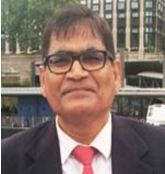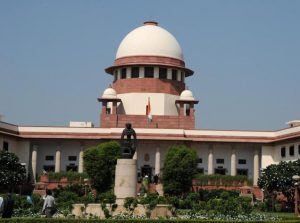 Prof Satya Narayan Misra in Bhubaneswar, April 27, 2022: On this date 49 years ago, three judges of the Supreme Court viz. Shelat, Hegde & Grover submitted their resignation as justice N Roy who was junior to them was appointed on 25thApril as the new CJI of India.
Prof Satya Narayan Misra in Bhubaneswar, April 27, 2022: On this date 49 years ago, three judges of the Supreme Court viz. Shelat, Hegde & Grover submitted their resignation as justice N Roy who was junior to them was appointed on 25thApril as the new CJI of India.
The Govt. of day decided to supersede the judges as they were part of the majority verdict in the Keshabananda Bharati case (1973) which had enunciated the basic structure doctrine and had decreed that the power of the parliament to amend and alter the constitution was not unlimited.
Justice Ray who was selected as the new CJI to take over from justice SM Sikri had earlier decided three major cases in favor of central govt., viz. Bank Nationalization case, Privy Purse case and Keshabananda case.
“Mrs. Gandhi had struck a grievous blow to the Independence of judiciary” said Justice Hans Raj Khanna who was ironically was superseded as CJI for giving a dissenting judgement in the ADM Jabalpur Vs SP Shukla case (1976), where he upheld right to life and liberty even during imposition of national emergency.
Justice HR Khanna was also part of the majority verdict in Keshabananda Bharati case and he was the main architect of observing that right to property need not be a Fundamental right unlike right to life to liberty. In fact, right to property became an ordinary right through the 44th amendment and a new provision article 300A was added to the constitution. It would be interesting to go through the dissenting judgement given by justice HR Khanna in the ADM Jabalpur case.
The issue involved was whether a person arrested during imposition of emergency can approach the high court and Supreme Court against illegal detention. Surprisingly Justice PN Bhagawati who has contributed significantly to public interest litigation in the 80s was of the view,
“However unfortunate the situation might be, that cannot be helped”. Justice Beg who was part of the majority judgement had observed “liberty is a gift of law and made by law and can be forfeited or abridged. But the most surprising defense was adduced by the then Attorney General Niran De who said “even if life was taken illegally, courts are helpless”.
In a startling dissenting opinion Justice Khanna had observed that neither life nor liberty are bounties conferred by the state, nor did the constitution create these rights. For him, detention without trial is an anathema to all those who love personal liberty.
Justice Khanna was fully aware that by giving such a dissenting judgement he will be superseded to the post of CJI. Lo and Behold, he was superseded by Justice Beg who was considered a committed judge!. Justice Khanna had observed later “a constitution is not a parchment of paper. Imbecility of men, history says always invites the impudence of power”.
Fali Nariman, in his autobiography Before Memory Fades writes “it is not enough for the judiciary to be independent of the executive”. They must be seen to have noble quality of mind and heart and above all courage. All these quality were displayed by Justice Khanna. The New York Times in an edit after the judgement wrote “if India ever finds its way back to the freedom and democracy, someone will surely build a monument to Justice Khanna of the Supreme Court.
 After Supreme Court was stung by the bee of suppression in 1973 and 1977, it has strongly bounced back to assert its independence. The first blow it struck on the govt. was by striking the 39th amendment which tried to take away the power of election commissioner to adjudicate on the election of the president, vice president, prime Minister and Speaker by introducing Art 329A. Mr Seervai believes that this judgement asserted the rule of law and principle of equality which has been enshrined in the constitution as a fundamental right.
After Supreme Court was stung by the bee of suppression in 1973 and 1977, it has strongly bounced back to assert its independence. The first blow it struck on the govt. was by striking the 39th amendment which tried to take away the power of election commissioner to adjudicate on the election of the president, vice president, prime Minister and Speaker by introducing Art 329A. Mr Seervai believes that this judgement asserted the rule of law and principle of equality which has been enshrined in the constitution as a fundamental right.
The second definitive judgment has been striking down clauses 4 &5 in to article 368 through the 44th amendment in 1978 which tried to affirm parliamentary supremacy to amend the constitution and take away the power of judicial review. In the Minerva mills case (1980) the Supreme Court reminded the government of the famous Madison Vs Marbury case (1803), where Chief Justice Marshal of USA struck down an irregular legislation by the US Congress.
This was the first time in which the Supreme Court adjudicated legality of a congress law and asserted court’s independence of adjudicating its constitutionality through judicial review. The Minerva mills case struck down both new clauses in Art 368 and reminded the parliament that the creature (Parliament) cannot obliterate the creator (Constitution).
Striking down article 329A in 1975 and clauses 4 & 5 of article 368 has been generally well received by all political parties. However, striking down of the NJAC Act in 2015 by the Supreme Court is generally perceived as a controversial one. It may be recalled that the proposed act was to substitute the opaque collegium system which was introduced in 1993 for selecting judges in High Court and Supreme Court by CJI and four senior Supreme Court judges.
On the face of it, it looks as if the judiciary is trying to protect its turf after being arbitrarily sledge hammered in the 70s through suppression of judges. Since independent and competent judges are the life breath of objectivity in decision making, one hopes that the judiciary should opt for more transparent system for selection of judges based on merit and transparency. Justice Hidayatualla after the suppression of judges in April 1973 had observed: this was an attempt of crating not forward looking judges but judges looking forward to the plumes of the office of Chief Justice.
Sir Harry Gibbs Chief Justice of Australia has aptly observed “the interest of a community requires that neither political nor personal patronage should play a part in making judicial appointments.’ The suppression in 1973 and the collegium system in 1993 seem to echo the concerns raised by Sir Gibbs. It is a great relief that the sordid suppression of April 1973 is behind us and hopefully will not be repeated.


Leave a Reply
Be the First to Comment!